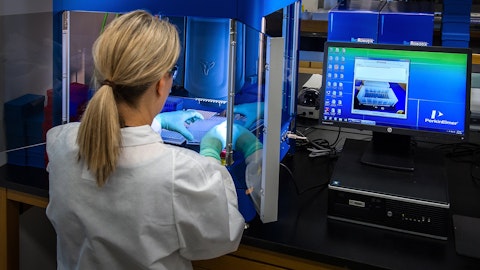Steven Lichtman: Got it. Thank you.
Operator: One moment for our next question. The next question comes from Richard Newitter with Truist Securities. Your line is open.
Richard Newitter: Hi, thanks for taking the questions. Maybe just going back to Kristen’s gross margin question. I think you had suggested that by first half 2025, gross margin should be more normalized. First, did I hear that correctly? And then, I guess, just looking beyond second half 2024, is there any reason that you wouldn’t be back to historical levels, say, 2022 margin levels? And then I have a follow-up.
Lea Knight: Yes, certainly. So — and just to be clear, we are not providing guidance with respect to 2025. So our data guidance is that we would expect a modest improvement in gross margin in 2024 over 2023. For 2025, again, as we bring the full product portfolio back online for Boston, we’d expect some of the headwinds that we saw in 2023 to reverse, right, especially from a mix perspective. So that’s the improvement that I was referencing. On top of that, there are these additional projects that I mentioned that we’re launching in 2024 to extract additional value out of our supply chain and operational efficiency that should also contribute to gross margin improvement in 2025 over 2024. But at this point, we would not dimensionalize exactly how much that value would be. We have more work to do before we’re in a position to determine that. And we got a follow-on…
Richard Newitter: I’m sorry. Go ahead.
Lea Knight: I thought there was a second part to your question.
Richard Newitter: Yes, yes. Sorry. Yes. So just one on CUSA. Is that all just comps year-over-year? Or are there competitive pressures potentially to be considering as well? And does that mean that growth snaps back in the back half on easier comps? And then also just if you — I’m not sure if I have heard. Did you indicate whether or not you — or timing of FDA PMA inspection for SurgiMend? Thank you.
Lea Knight: So I’ll take the CUSA comp question, and then I’ll let Jan respond on the SurgiMend. From a CUSA perspective, so in Q1, yes, what we are seeing are much more difficult comps based on what happened in Q1 2023, and that is the primary driver. There is — because we are in the later stages of our refresh cycle, the growth rates do naturally slow as a result of that. And so that’s a contributing factor as well. Again, it doesn’t impact the size of our installed base. That is still growing. It’s just growing at a lower rate than what we’ve seen previously.
Jan De Witte: Okay. On the SurgiMend inspection, so the pre-approval inspection, we still expect that to happen in the second half of this year in light of getting PMA in 2025 for SurgiMend.
Richard Newitter: Thank you.
Operator: One moment for our next question. Our next question comes from Craig Bijou with BofA Securities. Your line is open.
Craig Bijou: Good morning. Thanks for taking the question. So I wanted to go back to the Boston impact and just kind of what you guys are assuming for the second half SurgiMend and PriMatrix. I mean, if I look at the numbers, including the Q1 impact and then the full year impact, it looks like it may be $25 million or so in the second half — of about $25 million of revenue in the second half. So I wanted to see if that was right. And then if I remember correctly, the Boston products were run rating a little bit over $80 million, I think, as of — in 2022. So wanted to know what piece or what percentage of that was private label. I think you’ve talked about that in the past.
Lea Knight: Yes, yes. So — and so let me back up and just frame out. So you’re right. The business in Boston, we size it about kind of 5% of our total business, which is roughly the $80 million. Within that, the private label piece is about 20%, and commercial business is about 80%, right? When we first talked about the potential impact in 2024 as a result of Boston, we frame that out as a $50 million impact. So off of an $80 million starting point, you get to an expectation that for 2024, we’ll be about $30 million. But that — and the guidance we’re providing now takes out of that the private label piece, which is why our guidance in terms of the tailwind that Boston is providing in 2024 is 60 basis points versus what should have been closer to or could have been closer to 150 to 200 basis points.
Craig Bijou: Got it. Thanks. That’s helpful. And then on Codman, so understand and appreciate the color that you’re giving with CUSA and the comps and where you are in that replacement — or the placement cycle. How should we think about Codman growth in 2024? Is it going to be at the lower end given some of the dynamics, the lower end of your LRP, that 3% to 5%, I believe?
Lea Knight: Yes. So Codman actually had really strong growth. And again, if I could just step back and look at 2023. On a full year basis, our growth across that division was 4.8%, which is actually at the higher end of the range that we anticipate for that business. And as we continue into 2024, we’ll continue to see that business operate in that strong mid-single-digit sort of area. And so, yes, definitely don’t anticipate any kind of slowing down, if you will, for that part of our business.
Craig Bijou: Great. Thanks for taking the questions.
Operator: One moment for our next question. Our next question comes from Dave Turkaly with Citizens JMP. Your line is open.
David Turkaly: Hi, good morning. I think, last quarter, we talked about expecting sort of a 10% to 15% replacement rate maybe for the products that were off. And I was just curious, based on the comments and maybe even on Skin, are you running a little bit below that? Or any update you can give us there?
Jan De Witte: Yes. That replacement rate is still around that range definitely in the wounds. And yes, it’s one of the factors that drove a strong Skin demand and why our inventories over that — the past several quarters have further depleted, a bit more vulnerable to some yield effects on the line. Yes. Overall, that replacement was in that range.
David Turkaly: And then maybe for Lea, appreciate the headwinds in 1Q. But if you look at the Skin supply and then CUSA — and I was wondering if you might rank them or quantify them maybe in terms of that revenue and/or the EPS impact do you think they’re going to have in that first quarter, again, recognizing that EPS number was certainly the most impacted.
Lea Knight: Yes. So I think if I had dimensionalize for you the impact, the Skin impact is probably the larger determinant for why, on a Q1 basis, our growth outside of Boston is not what we would anticipate in terms of single-digit growth, with CUSA Clarity being kind of the next element. And again, part — a big part of that being the comp.
David Turkaly: Great. Thanks.
Operator: One moment for our next question. Our last question comes from Joanne Wuensch with Citi. Your line is open.
Joanne Wuensch: Thank you very much for taking the question. And Jan, congratulations on retirement. I’m just sort of curious, as you go about the search what you’re thinking the next CEO should bring to the table and what he or she may do differently. And then I’ll toss my second question in now. There was commentary during the call about it sounds like you’re refocused or an increased focus on international opportunities. Can you sort of frame that and how you think about funding it and the time frame to accelerating it? Thank you.
Jan De Witte: So on the CEO succession, like we communicated, I mean, the Board has put a search committee in place. We’re working with Heidrick & Struggles to do a thorough and deliberate search to find a CEO successor that. On the one hand, it comes with proven track record of driving profitable growth businesses and, at the same time, further building out a high-performing organization. From a strategy perspective, I mean, the strategy that we’ve been driving over the past couple of years, the strategy that we built with the executive leadership team and our Board going after commercial acceleration with new product development, digital, building out our position in the care pathways, both organic and inorganic and driving international, that strategy remains intact.
And my focus this year with the leadership team is making sure not just to deliver the 2024 plan, but also further drive that momentum behind that strategy. And expectation is that we’ll continue in that direction. In terms of international, we had a great international year. It is one of the strategic levers, and it will remain one of the strategic levers where we can further drive our penetration and commercial execution, not just in China, but in the breadth of international countries outside the U.S.
Joanne Wuensch: Thank you.
Operator: Thank you. Ladies and gentlemen, this does conclude today’s presentation for today. You may now disconnect, and have a wonderful day.



